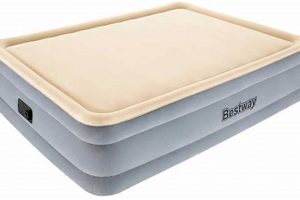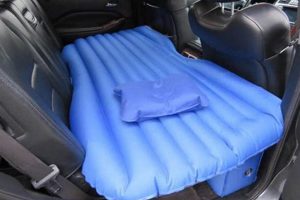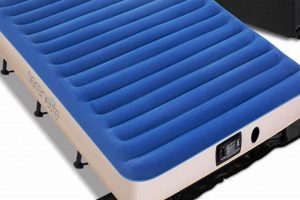The process of repairing a puncture in a portable inflatable sleeping surface involves sealing the breach to prevent air leakage. Successful repair restores the functionality of the item, allowing it to maintain its intended firmness and provide support. Examples include applying adhesive patches, using specialized repair kits, or employing sealant materials to close the opening.
Addressing damage to these inflatable structures is important for several reasons. It prevents the need for premature replacement, saving resources and reducing waste. Historically, various methods have been employed, from makeshift solutions using readily available materials to sophisticated techniques involving advanced adhesives and polymers. The benefits extend to both cost savings and environmental responsibility, ensuring the prolonged usability of the product.
The following sections will detail preparation techniques, identify suitable materials, describe the step-by-step process, and explore preventive measures to minimize future damage and maintain the integrity of inflatable sleeping surfaces.
Tips for Effective Repair
These recommendations are designed to provide guidance for successful mending of inflatable sleeping surfaces, maximizing lifespan and performance.
Tip 1: Thoroughly Clean the Area. Before applying any sealant or patch, ensure the affected area is free from dirt, dust, and oils. Isopropyl alcohol can be used to degrease the surface, promoting optimal adhesion.
Tip 2: Precisely Locate the Leak. Inflate the item and listen carefully for escaping air, or use a soapy water solution to identify the exact point of the puncture. Mark the location clearly with a pen or marker.
Tip 3: Use the Correct Patch Material. Match the patch material to the composition of the inflatable surface. Vinyl patches are typically suitable for vinyl surfaces, while specialized fabrics may be required for other materials.
Tip 4: Apply Even Pressure During Adhesion. When applying a patch, ensure consistent and firm pressure is applied across the entire surface of the patch. Use a smooth, hard object like a rolling pin to ensure proper bonding.
Tip 5: Allow Adequate Curing Time. Follow the manufacturer’s instructions regarding curing time for the adhesive used. Premature use may compromise the bond and lead to future air loss.
Tip 6: Reinforce Larger Tears. For tears exceeding a small puncture, consider applying multiple layers of patching material or using a fabric backing to provide additional structural support.
Tip 7: Regularly Inspect for Deterioration. Periodically examine patched areas for signs of peeling or air leakage. Early detection allows for timely reapplication and prevents catastrophic failure.
Adhering to these guidelines can significantly increase the longevity and usability of inflatable sleeping surfaces, reducing the frequency of replacements and minimizing environmental impact.
The concluding section will summarize the entire process and offer final recommendations for long-term maintenance.
1. Surface Preparation Critical
Effective sealing of a puncture in an inflatable sleeping surface hinges significantly on the thoroughness of surface preparation. Contaminants such as dirt, oils, and moisture inhibit the adhesive bond between the patching material and the mattress surface. This lack of adhesion results in air leakage and premature patch failure, negating the repair attempt. For example, applying a vinyl patch directly onto a greasy surface will likely yield a temporary seal, quickly deteriorating with use and pressure.
The process of cleaning involves more than simply wiping the area. Degreasing agents, such as isopropyl alcohol, are required to remove oily residues effectively. Abrasive cleaning, using fine-grit sandpaper, can also create a textured surface, increasing the surface area available for adhesion. Without proper surface preparation, even the highest-quality patching materials and adhesives will fail to create a lasting bond. This component of “patch hole on air mattress” is the most crucial.
In summary, attention to surface preparation is not merely a preliminary step; it is a fundamental requirement for achieving a durable and effective mending. Neglecting this phase directly compromises the entire repair process, leading to frustration and potential loss of the inflatable item. Adherence to rigorous cleaning protocols ensures the longevity and functionality of the repaired surface, maximizing its usability.
2. Adhesive Type Selection
The effectiveness of repairing a puncture in an inflatable sleeping surface is inextricably linked to the selection of an appropriate adhesive. The adhesive serves as the crucial interface, bonding the patch material to the mattress surface, thereby preventing air leakage. The choice of adhesive must, therefore, be carefully considered based on the composition of the inflatable material. For instance, a polyvinyl chloride (PVC) mattress necessitates a PVC-specific adhesive, while a flocked surface may require an adhesive formulated for fabric bonding. Using an incompatible adhesive will result in a weak or non-existent bond, leading to patch failure under pressure. Consider a scenario where cyanoacrylate adhesive (“super glue”) is used on a PVC mattress; the rigid nature of the cured adhesive will not accommodate the flexibility of the PVC, causing it to crack and detach, resulting in renewed air leakage.
The characteristics of an ideal adhesive for inflatable mattress mending include flexibility, water resistance, and strong bonding capability. Flexibility ensures the patch can move with the mattress without detaching, crucial during inflation and deflation cycles. Water resistance is imperative to prevent degradation of the bond in humid environments or during cleaning. High bonding strength guarantees the patch remains securely attached under the pressure of the inflated mattress. Specific examples of suitable adhesives include those based on vinyl polymers for PVC mattresses, polyurethane adhesives for fabric-reinforced mattresses, and specialized rubber cements for certain synthetic rubber materials. The adhesive must also exhibit resistance to plasticizers present in many inflatable materials to prevent breakdown of the adhesive bond over time.
In conclusion, the selection of an appropriate adhesive is a critical determinant of the long-term success of any mending attempt. Mismatched adhesive-material pairings inevitably lead to patch failure and necessitate repeated repairs. Understanding the material properties of both the inflatable mattress and the adhesive is essential for ensuring a durable and airtight repair. This knowledge minimizes waste, extends the lifespan of the inflatable item, and contributes to a more sustainable consumption model.
3. Pat
ch Material Compatibility
The efficacy of mending a puncture in an inflatable sleeping surface is inextricably linked to the compatibility between the patching material and the composition of the mattress itself. The selection of an inappropriate patch can result in inadequate adhesion, compromised structural integrity, and ultimately, failure to maintain air pressure within the mattress.
- Material Composition Matching
The chemical and physical properties of the patch must be congruent with those of the mattress material. For instance, a vinyl mattress mandates a vinyl patch due to the inherent adhesive compatibility and flexibility. Utilizing a fabric patch on a vinyl surface, conversely, would likely lead to peeling and air leakage due to disparate expansion/contraction rates and bonding characteristics under stress.
- Adhesive Compatibility
Even with similar material composition, the adhesive used to bond the patch must be designed for the specific materials involved. A general-purpose adhesive may not provide sufficient bonding strength or resistance to plasticizers present in the mattress material, leading to premature failure. Specialized adhesives are often required to ensure a durable, airtight seal.
- Thickness and Flexibility Considerations
The patch should ideally match the thickness and flexibility of the mattress material to prevent stress concentrations at the patch edges. A patch that is significantly thicker or more rigid can create a point of weakness, leading to further tearing or separation. Likewise, insufficient flexibility can cause the patch to detach during inflation and deflation cycles.
- Environmental Resistance
The patch material should exhibit resistance to environmental factors such as temperature fluctuations, humidity, and ultraviolet (UV) exposure, depending on the intended use of the mattress. Degradation of the patch due to environmental factors can compromise the seal and reduce the lifespan of the repair.
In summary, the successful remediation of a compromised inflatable sleeping surface depends fundamentally on the careful selection of a patch material that is chemically, physically, and environmentally compatible with the mattress material. The failure to adhere to these principles undermines the mending process, rendering the repair ineffective and ultimately necessitating replacement of the entire mattress. The cost-effectiveness of the operation depends on selecting the proper material.
4. Application Technique Precision
The durability and effectiveness of repairing a breach in an inflatable sleeping surface are fundamentally dependent on the precision with which the patching material is applied. A meticulous approach, characterized by adherence to established protocols, is essential for achieving a hermetic seal and preventing subsequent air leakage.
- Surface Alignment and Positioning
Prior to bonding, the patch must be precisely aligned with the defect. Misalignment can create stress points and uneven distribution of adhesive, leading to premature failure. The patch should extend sufficiently beyond the perimeter of the breach to ensure a secure bond to the surrounding intact material. Correct positioning minimizes the risk of air pockets.
- Adhesive Distribution and Uniformity
The adhesive must be applied evenly across both the patch and the prepared surface of the mattress. Insufficient adhesive leads to weak bonding, while excessive adhesive can create bubbles and impede proper contact. The manufacturer’s recommendations regarding adhesive application thickness and coverage should be strictly adhered to for optimal results. Proper distribution creates a strong bond.
- Pressure Application and Curing Time
Following patch placement, uniform pressure must be applied to the entire surface to ensure intimate contact between the patch and the mattress. Consistent pressure, maintained for the duration of the recommended curing period, facilitates optimal adhesive bonding. Failure to apply adequate or sustained pressure can compromise the integrity of the seal. Correct pressure ensures proper bonding during curing.
- Edge Sealing and Reinforcement
Particular attention should be paid to the edges of the patch. Applying a thin bead of sealant around the perimeter can further enhance the airtight seal and prevent peeling. For larger breaches or areas subject to high stress, reinforcing the patch with additional layers of material may be necessary. Correct sealing provides extra protection.
In conclusion, the long-term viability of mending depends on the rigorous execution of precise application techniques. Neglecting any of these facets can undermine the entire operation, resulting in recurring air leakage and necessitating frequent re-patching or complete replacement of the inflatable sleeping surface. Attention to detail in the application phase is paramount for ensuring a durable and cost-effective repair.
5. Pressure Distribution Uniformity
The uniform dispersal of force across the surface of a patch applied to an inflatable sleeping surface is critical for achieving a durable and airtight seal. Uneven pressure distribution can compromise the adhesive bond, leading to air leakage and premature patch failure. Proper technique, therefore, must prioritize consistent pressure to ensure optimal adhesion.
- Adhesive Contact Maximization
Consistent force ensures the adhesive fully wets both surfaces the patch and the mattress maximizing contact area. This maximizes van der Waals forces between adhesive molecules and the mattress/patch interface, which are the primary mechanism for adhesion. Any areas lacking consistent pressure reduce the effective bonded area and increase the likelihood of air escaping.
- Stress Reduction at Patch Edges
Uneven pressure concentrates stress at the edges of the patch. These edges are already vulnerable to peeling due to mechanical forces. Concentrated stress accelerates this process, leading to a progressive detachment of the patch. Uniform pressure distributes stress more evenly across the patch area, minimizing the risk of edge failure.
- Prevention of Air Pocket Formation
Air pockets trapped between the patch and mattress surface impede adhesive bonding. These pockets act as stress concentrators and create pathways for air leakage. Uniform pressure forces out any trapped air, ensuring a complete and intimate contact between the patch and the mattress surface, eliminating potential leakage paths.
- Optimization of Curing Process
Many adhesives require a specific pressure during the curing process to achieve optimal strength and flexibility. Uneven pressure during curing can result in variations in adhesive properties across the patch area, leading to localized weaknesses and an increased risk of failure. Uniform pressure ensures consisten
t adhesive properties throughout the bonded area.
The principles of uniform pressure distribution are essential for successful mending. Without proper attention to this aspect, even the most carefully selected materials and adhesives are unlikely to yield a long-lasting repair. Therefore, application techniques must prioritize the consistent application of force to ensure optimal performance and extended lifespan.
Frequently Asked Questions About Repairing Inflatable Sleeping Surfaces
This section addresses common inquiries and clarifies misconceptions regarding the effective mending of inflatable sleeping surfaces, providing detailed answers grounded in established repair techniques.
Question 1: Is it always necessary to use a specialized patch kit to repair a puncture?
While specialized kits offer convenience and pre-cut materials, they are not always mandatory. The suitability of alternative materials depends on the size and nature of the damage, the composition of the mattress, and the availability of appropriate adhesives. However, specialized kits typically offer a higher probability of a durable repair.
Question 2: How can the precise location of a small leak be identified?
Submerging the inflated mattress in water and observing for air bubbles is a reliable method. Alternatively, applying a soapy water solution to the surface and watching for bubble formation can pinpoint the source of the leak. Accurate identification is crucial for effective patching.
Question 3: What type of adhesive is most suitable for repairing a vinyl inflatable mattress?
Adhesives specifically formulated for vinyl surfaces, typically containing vinyl polymers, offer the best bonding characteristics. Cyanoacrylate adhesives (“super glue”) are generally not recommended due to their rigidity and tendency to crack under stress.
Question 4: How long should pressure be applied to a patch during the curing process?
The duration of pressure application depends on the specific adhesive used. The manufacturer’s instructions should be consulted and strictly adhered to. Generally, a minimum of several hours under consistent pressure is recommended to ensure a robust bond.
Question 5: Can a significantly large tear be effectively repaired, or is replacement necessary?
The feasibility of repairing a large tear depends on its size and location. Tears exceeding several inches may compromise the structural integrity of the mattress and necessitate replacement. However, reinforcement techniques, such as fabric backing, can sometimes salvage the item.
Question 6: What preventive measures can be taken to minimize the risk of future punctures?
Protecting the mattress from sharp objects, using a protective ground cover, avoiding over-inflation, and storing the mattress properly when not in use are all effective preventive measures. Regular inspection for signs of wear and tear can also facilitate early detection and repair of minor damage.
In summary, successful mending involves careful material selection, precise application techniques, and adherence to recommended procedures. Proper execution maximizes the lifespan of inflatable sleeping surfaces and minimizes the need for premature replacement.
The subsequent section will offer a concluding overview of the entire repair process and provide final recommendations for long-term maintenance and care.
Conclusion
The examination of patching breaches in inflatable sleeping surfaces reveals a multifaceted process demanding careful consideration of materials, techniques, and environmental factors. Proper surface preparation, adhesive selection, patch compatibility, application precision, and pressure uniformity are not merely procedural steps, but essential determinants of long-term repair success. A failure to address any of these dimensions can compromise the structural integrity of the repaired item, leading to recurring air leakage and premature product obsolescence. The long term effectiveness hinges on the quality and technique brought to the repair.
Therefore, diligent adherence to best practices is paramount. Individuals responsible for maintaining or repairing these items must understand the underlying principles governing effective adhesion and stress distribution. The proper repair extends the useful life of the product, decreasing unnecessary material waste. This extends beyond simple cost savings to responsible consumption and environmental stewardship, necessitating a commitment to informed and conscientious practices in the mending process.







